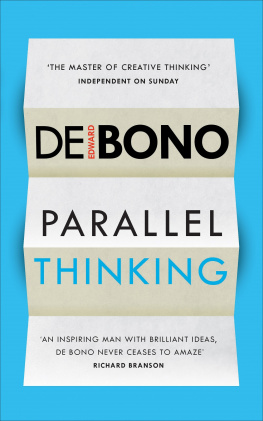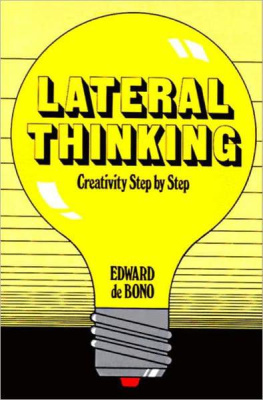CONTENTS
ABOUT THE AUTHOR
Edward de Bono is the leading authority in the field of creative thinking and the direct teaching of thinking as a skill. While there are thousands of people writing software for computers, Edward de Bono is the pioneer in writing software for the human brain. From an understanding of how the human brain works as a self-organising information system, he derived the formal creative tools of lateral thinking. He is also the originator of parallel thinking and the Six Thinking Hats. His tools for perceptual thinking (CoRT and DATT) are widely used in both schools and business.
Edward de Bonos instruction in thinking has been sought by many of the leading corporations in the world, such as IBM, Microsoft, Prudential, BT (UK), NTT (Japan), Nokia (Finland) and Siemens (Germany). The Australian national cricket team also sought his help and became the most successful cricket team in history.
A group of academics in South Africa included Dr de Bono as one of the 250 people who had most influenced humanity in the whole course of history. A leading Austrian business journal chose him as one of the 20 visionaries alive today. The leading consultancy company, Accenture, chose him as one of the 50 most influential business thinkers today.
Edward de Bonos methods are simple but powerful. The use of just one method produced 21,000 ideas for a steel company in one afternoon. He has taught thinking to Nobel prize winners and to young people with Downs syndrome.
Edward de Bono holds an MD (Malta), MA (Oxford), DPhil (Oxford), PhD (Cambridge), DDes (RMIT) and LLD (Dundee). He has had faculty appointments at the universities of Oxford, Cambridge, London and Harvard and was a Rhodes Scholar at Oxford. He has written over 70 books with translations into 40 languages and has been invited to lecture in 58 countries.
The Edward de Bono Foundation is concerned with the teaching of constructive thinking in Education and Management. For further information contact:
The Edward de Bono Foundation
PO Box 2397
Dublin 8
Ireland
Tel: +353 1 8250466
Email:
Website: www.edwarddebonofoundation.com
IN PRAISE OF EDWARD DE BONO
Edward doesnt just think. He is a one-man global industry, whose work is gospel in government, universities, schools, corporates and even prisons all over the world Times 2
The master of creative thinking Independent on Sunday
Edward de Bono is a cult figure in developing tricks to sharpen the mind The Times
Edward de Bono is a toolmaker, his tools have been fashioned for thinking, to make more of the mind Peter Gabriel
de Bonos work may be the best thing going in the world today George Gallup, originator of the Gallup Poll
The guru of clear thinking Marketing Week
www.edwarddebono.com
INTRODUCTION
Everyone wants to be creative.
Everyone should want to be creative. Creativity makes life more fun, more interesting and more full of achievement.
Research shows that 94 per cent of youngsters rate achievement as the most important thing in their lives. Creativity is the key skill needed for achievement.
Without creativity there is only repetition and routine. These are highly valuable and provide the bulk of our behaviour but creativity is needed for change, improvement and new directions.
In business, creativity has become essential. This is because everything else has become a commodity available to everyone.
If your only hope of survival is that your organisation will continue to be more competent than your competitors, that is a weak position. There is nothing you can do to prevent your competitors also becoming competent.
Information has become a commodity available to everyone. Current technology has become a commodity with a few exceptions where a 16-year patent life offers some protection.
Imagine a cooking competition with several chefs at a long table. Each chef has the same ingredients and the same cooking facility. Who wins that competition?
At the lower level the chef with the highest quality wins. But at the higher level all chefs have excellent quality. So who wins? The chef who can turn the same ingredients into superior quality.
In business, competing with India and China on a price basis is impossible. That leaves creating new value as the basis for competition. And that needs a more serious commitment to creativity than is the case at the moment.
CREATIVITY AS TALENT
Too many people believe that creativity is a talent with which some people are born and the rest can only envy. This is a negative attitude that is completely mistaken.
Creativity is a skill that can be learned, developed and applied.
I have been teaching creative thinking for over 30 years to a wide variety of people:
from four-year-olds to 90-year-olds
from Downs syndrome children to Nobel prize laureates
from illiterate miners in Africa to top executives
Using just one of the techniques of lateral thinking, a group of workshops generated 21,000 ideas for a steel company in one afternoon.
UNINHIBITED
An ordinary man is walking down the road. A group of people seize him and tie him up with a rope. Then a violin is produced. Obviously, the man tied up with the rope cannot play the violin. So what do we say? We claim that if the rope was cut the man would play the violin. This is clearly nonsense. Cutting the rope does not make the man a violinist.
Unfortunately we have the same attitude towards creativity. If you are inhibited it is difficult to be creative. Therefore if we make you uninhibited you will be creative!
This is the basis of brainstorming and other popular techniques. There is some merit in these systems but the approach is a very weak one. The formal and deliberate tools of lateral thinking are much more powerful.
The brain is designed to be non-creative. If the brain were creative, life would be impossible. With 11 pieces of clothing to put on in the morning there are 39,916,800 ways of getting dressed. If you tried one way every minute you would need to live to be 76 years old using your entire waking life trying ways of getting dressed.
Fortunately for us, the brain is designed to form stable patterns for dealing with a stable universe. That is the excellence of the brain and for that we should be very grateful.
So removing inhibition is of value but only a weak way of developing creativity.
CREATIVITY AS SKILL
Creativity is a skill that everyone can learn, practise and use.
It is as much a skill as skiing, playing tennis, cooking or learning mathematics.
Everyone can learn such skills. At the end not everyone is going to be equally good at these skills. Some people cook better than others. Some people play tennis better than others. But everyone can learn the skill. And everyone can seek to get better through practice.
CREATIVITY IS NOT A MYSTERY
For the first time in history we can now look at creativity as the logical behaviour of a certain type of information system. The mystery and mystique can be removed from creativity.
1. We need to look at the human brain as a self-organising information system.
2. Self-organising information systems form patterns.
3. All pattern-making systems are asymmetric.
4. This is the basis of humour and of creativity. Humour is by far the most significant behaviour of the human brain because it indicates the nature of the underlying system. Reason tells us very little because any sorting system run backwards is a reasoning system. Humour indicates asymmetric patterns. This means that the route from A to B is not the same as the route from B to A.
Next page

















